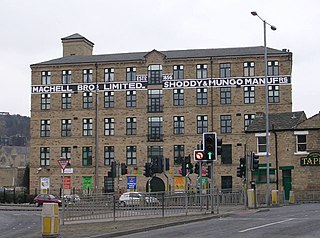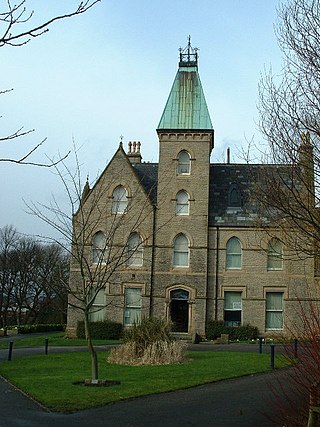
West Yorkshire is a metropolitan and ceremonial county in the Yorkshire and the Humber region of England. It borders North Yorkshire to the north and east, South Yorkshire and Derbyshire to the south, Greater Manchester to the south-west, and Lancashire to the west. The city of Leeds is the largest settlement.

Batley is a market town in the Metropolitan Borough of Kirklees, West Yorkshire, England, south-west of Leeds, north-west of Wakefield and Dewsbury, south-east of Bradford and north-east of Huddersfield, in the Heavy Woollen District. In 2011, the population was 48,730.

Red House Museum was a historic house museum, built in 1660 and renovated in the Georgian era. It closed to the public at the end of 2016 but remains as a Grade II* listed building in Gomersal, Kirklees, West Yorkshire, England.

Kirklees is a metropolitan borough of West Yorkshire, England. The borough comprises the ten towns of Batley, Birstall, Cleckheaton, Dewsbury, Heckmondwike, Holmfirth, Huddersfield, Meltham, Mirfield and Slaithwaite. It is governed by Kirklees Council. Kirklees had a population of 422,500 in 2011; it is the third-largest metropolitan district in England by area, behind Doncaster and Leeds.

Huddersfield is a market town in the Metropolitan Borough of Kirklees in West Yorkshire, England. It is the administrative centre and largest settlement in the Kirklees district. The town is in the foothills of the Pennines. The River Holme's confluence into the similar-sized Colne is to the south of the town centre which then flows into the Calder in the north eastern outskirts of the town.

Skelmanthorpe is a village in the Denby Dale civil parish, in the metropolitan borough of Kirklees, in West Yorkshire, England. It is 8 miles (13 km) south-east of Huddersfield. According to the 2011 census, the village had a population of 4,549.

The Colne Valley is a steep sided valley on the east flank of the Pennine Hills in the English county of West Yorkshire. It takes its name from the River Colne which rises above the town of Marsden and flows eastward towards Huddersfield.

The Heavy Woollen District is a region of textile-focused industrial development in West Yorkshire, England. It acquired the name because of the heavyweight cloth manufactured there from the early 19th century.

Clayton West is a village in the parish of Denby Dale, in Kirklees, West Yorkshire, England. It had a population of 4.386 and 2,704 in 2008. It is 9 miles (14 km) south-east of Huddersfield and 7 miles (11 km) north-west of Barnsley.

Shepley is a village in the civil parish of Kirkburton, in Kirklees, West Yorkshire, England. It lies 8 miles (13 km) south south east of Huddersfield and 6 miles (9.7 km) north west of Penistone.

Flockton is a village in the civil parish of Kirkburton, in Kirklees, West Yorkshire, England. It is halfway between Huddersfield and Wakefield. In 2020, the population of Flockton and Flockton Green was estimated to be 2,107.

Newsome is a village situated approximately 1 mile south of Huddersfield, West Yorkshire, England. It is in the Metropolitan Borough of Kirklees. The village lies at the centre of Newsome Ward to which it gives its name.
Gawthorpe, also known as Gawthorp, is a hamlet in the Kirklees district, in the English county of West Yorkshire, about 4 miles (6 km) east of Huddersfield. The nearest major road is the A642 which passes about 0.3 miles (0.5 km) south of the place. In the 19th century Gawthorpe was listed variously as a village or a hamlet in Lepton township, part of the parish of Kirkheaton in the West Riding of Yorkshire. Coal was mined at Gawthorpe around the middle of the 19th century.
Slack Roman Fort was a castellum near Outlane, to the west of Huddersfield in West Yorkshire, England. Its site is a scheduled monument. The ruins of the fort which lay alongside the Pennine section of the Roman road from Deva Victrix (Chester) to Eboracum (York) are no longer visible. The fort may have been the Cambodunum mentioned as a station on this route in the Antonine Itinerary.

Bagshaw Museum is a local museum in the town of Batley, West Yorkshire. Situated in Wilton Park, the elaborate Gothic Revival mansion was converted into a museum by Walter Bagshaw in 1911. Originally called the Wilton Park Museum, it was renamed after Bagshaw following his death in 1927.

Helen Tolson (1888–1955) was an English suffragette from Wilmslow in Cheshire active in the Women's Social and Political Union (WPSU). She was repeatedly arrested in 1908 and 1909.
Catherine Tolson was an English nurse and suffragette from Ilkley in West Yorkshire active in the Women's Social and Political Union. She was arrested and imprisoned in 1909 and 1911 when she went on hunger strike and was force-fed for which she received a Hunger Strike Medal from the WSPU. This was sold at auction in 2004.
Dalton is a ward of Huddersfield in the metropolitan borough of Kirklees, West Yorkshire, England. It contains 44 listed buildings that are recorded in the National Heritage List for England. All the listed buildings are designated at Grade II, the lowest of the three grades, which is applied to "buildings of national importance and special interest". The ward is to the east and the northeast of the centre of Huddersfield. The southern part of the ward is mainly residential, the eastern part is mainly industrial, and to the west and north are areas of countryside. The Huddersfield Broad Canal runs along the eastern part, and the listed buildings associated with it are locks, bridges and a warehouse. Most of the listed buildings in the residential parts are houses, cottages, shops and associated structures, and in the countryside they are farmhouses and farm buildings. The other listed buildings include churches and related structures, the remains of a hypocaust and a former cloth hall re-erected in a park, a road bridge, mill buildings and a mill chimney.

Seth Lister Mosley FES (1848–1929) was an English naturalist, ornithologist and curator who lived in Huddersfield, West Yorkshire. Born into a working-class family, he had little in the way of formal education.
Thomas William Woodhead (1863–1940) was an English plant ecologist. He was early proponent of ecology, who helped the growth of plant ecology as a discipline in England, and later became Professor of Biology at Huddersfield Technical College. He was also a pioneer of pollen analysis.

















